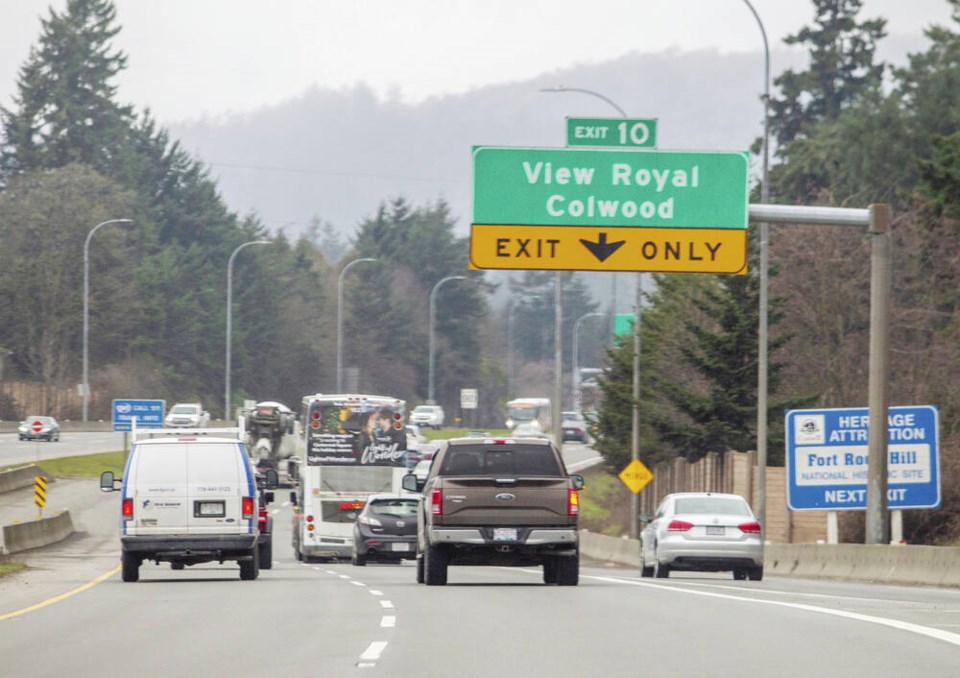The recent announcement by the City of Colwood about the creation of a $1.2-billion development in Royal Bay should give all CRD road users pause.
The plan calls for 2,850 homes plus retail and commercial space spread over 135 acres in the former quarry area. Despite the best of intentions by developers and planners in creating a world-class live, work and play enclave, one outcome is certain — there’ll be a lot more cars coming to the region’s streets, period.
It’s not just Colwood. Development throughout the lower Island seems to be exploding, with the corresponding effect on our roadways.
Last Sunday afternoon, I went south on Blanshard from Tolmie, heading downtown. I had a two-light wait just to get through Finlayson. For a guy who can remember a time when Pandora, Yates and Fort had so little volume they were two-way streets, a two-light wait on a Sunday is hard to swallow.
I have no doubt that there are people working harder than ever right now to develop a sustainable, efficient and common- sensical approach to ironing out the traffic woes of the CRD. Best of luck working through our local labyrinth.
Based on the emails I’m getting from readers around road safety, planners must start taking things a step further and build in much more around designed safety.
One program that seems to be working well in several cities around the world is called Vision Zero. The Vision Zero project was born in Sweden in 1997 and its goal is simple, if somewhat utopian: zero traffic deaths. Vision Zero sees it as ethically unacceptable that people are killed or seriously injured by our road transport system and suggests that, rather than road users bearing all responsibility for safety, responsibility must be shared with transportation-system designers.
The project has many goals, but here are some key ideas:
Local knowledge and input is essential. Neighbourhoods know where their road safety problems occur. Tapping into the experiences of what residents already know about their streets is both time and cost effective and creates buy-in.
A data-based, evidence-driven approach is also crucial. Several cities in the past few years adopted a low-cost method of trying to tackle speed problems by simply lowering their limits to reduce injuries and deaths.
However, their data collection quickly showed that simply lowering limits had little to no effect on the problem. Stepped-up enforcement by traffic cops and speed cameras made quite a difference, but is cost-prohibitive.
Armed with proper evidence, many cities using Vision Zero practices went instead to traffic-calming measures such as roundabouts, offsets, medians and central turn lanes, all built to manage driver speeds.
Over the past six years, Edmonton has gone all-in on this philosophy, installing 248 crosswalk upgrades, 237 safety improvements around schools, 212 driver-feedback speed signs and 105 intersection cameras, and improving 105 signalized intersections with engineering upgrades.
The results speak for themselves. Traffic-related fatalities have decreased by 63%, while serious injuries have decreased by 40%, and pedestrian fatalities and serious injuries have decreased by 54%. The injury cost savings must surely be in the tens of millions of dollars, not to mention the incalculable drop in simple human suffering.
Unchecked development, and the number of cars coming with it, seems to be the future for the CRD. I’ve scanned through several local and regional traffic plans. I was hard-pressed to find much on life-saving strategies similar to what Edmonton has adopted. A truly coherent and efficient rapid transit system will obviously help, but it’s still years away and I’m not sure why that’s taking so long.
As a driver, I’ll support spending money on common-sense planning that takes a regional approach to improving our transportation system — a system that feels harder and more frustrating to negotiate each day. So why not fill two needs with one deed and use some Vision Zero thinking. Saving lives should be as high a priority as plain old efficiency in moving cars through the increasingly congested CRD.
Glove Box: Following up on the pedestrian safety column last week, a reader was quick to remind me of a little-known requirement in our motor vehicle act — section 179(2). “A pedestrian must not leave a curb or other place of safety and walk or run into the path of a vehicle that is so close it is impracticable for the driver to yield the right of way.”
It’s a good reminder that safety is not solely about the drivers out there. I’d be happy with just converting those pedestrians who never turn their heads, even a bit, to see what’s headed at them before they step out.



